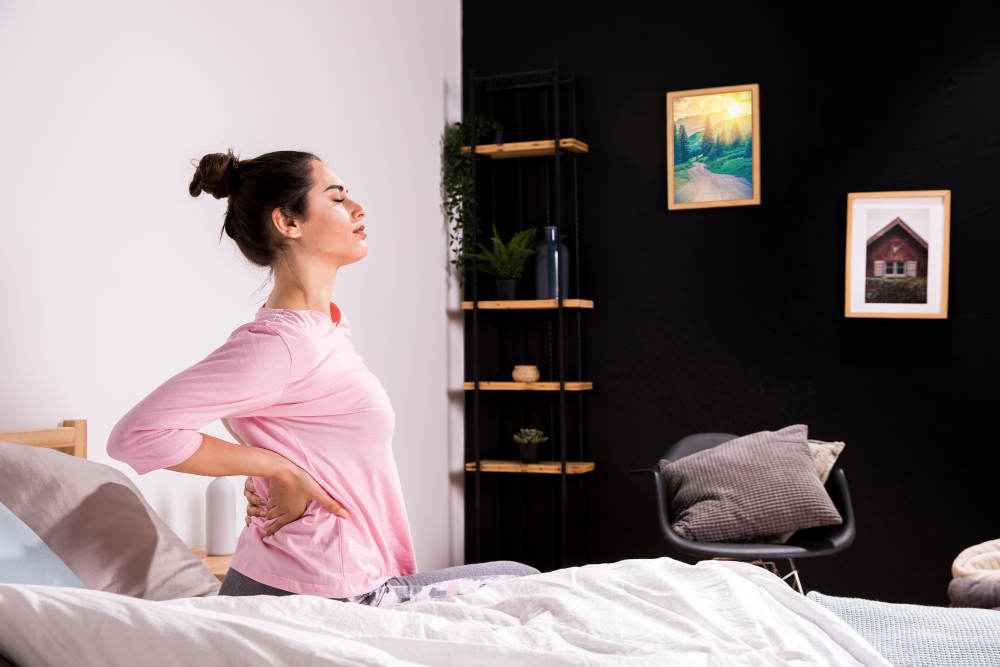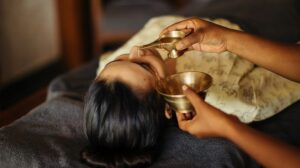Back pain is a modern-day epidemic, affecting a staggering 80% of adults at some point in their lives It disrupts daily routines, hinders work, and can significantly impact one’s quality of life. While conventional medicine offers solutions, Ayurveda, the ancient Indian system of holistic healing, provides a unique and effective approach to addressing the root cause of back pain and promoting lasting recovery.
This article explores Ayurvedic massage techniques specifically designed to target back pain and restore spinal health. We’ll delve into the Ayurvedic understanding of pain, the different types of back pain, and how Ayurvedic massage works to alleviate discomfort and promote long-term well-being.
Understanding Back Pain Through the Ayurvedic Lens
Unlike conventional medicine, which focuses on treating symptoms, Ayurveda views back pain as a manifestation of doshic imbalances. The three doshas – Vata, Pitta, and Kapha – govern all physiological and psychological functions in the body. When these doshas become aggravated or depleted, it disrupts the body’s natural equilibrium, leading to various health concerns, including back pain.
- Vata Dosha: Associated with air and space, Vata governs movement and circulation. When imbalanced, Vata can manifest as lower back pain, sciatica, and muscle spasms.
- Pitta Dosha: Fire and water govern Pitta, which controls digestion and metabolism. An aggravated Pitta can lead to upper back pain, stiffness, and inflammation.
- Kapha Dosha: Earth and water govern Kapha, responsible for structure and lubrication. When imbalanced, Kapha can cause heaviness, stiffness, and pain in the middle and lower back.
Common Causes of Back Pain from an Ayurvedic Perspective
Ayurveda identifies several factors that can contribute to doshic imbalances and back pain:
- Improper posture: Poor ergonomics, slouching, and lifting techniques can strain muscles and misalign the spine, leading to Vata-related back pain.
- Stress and anxiety: Chronic stress can aggravate Vata and Pitta, leading to muscle tension and pain.
- Dietary indiscretions: Irregular meals, excessive consumption of processed foods, and improper food combinations can disrupt digestion and aggravate Pitta, leading to back pain and inflammation.
- Lack of exercise: Physical inactivity weakens the muscles supporting the spine, leading to Vata-related back pain.
- Suppressed emotions: Holding onto negativity can aggravate Vata and Kapha, manifesting as back pain and stiffness.
Ayurvedic Massage Techniques for Back Pain Relief
Ayurvedic massage, known as Abhyanga, is a therapeutic practice that uses warm, medicated oils to manipulate the soft tissues, improve circulation, and promote relaxation. Here are some specific techniques used to target back pain:
- Snehana (Oleation): Warm, medicated oils are applied generously to the back using gentle stroking and kneading motions. This helps loosen tight muscles, improve blood flow, and reduce inflammation. The specific oil used is chosen based on the predominant dosha causing the pain.
- Marma Therapy: Marmas are vital points on the body’s energy channels. Stimulating specific marmas along the spine can help release blockages, improve nerve function, and alleviate pain.
- Pichu (Bolus): Medicated herbal paste or powders are applied to the affected area and covered with a cloth. This localized treatment helps draw out toxins, reduce inflammation, and promote healing.
- Padaabhyanga (Foot Massage): The feet are considered reflex zones for the entire body. Massaging the feet with specific oils helps balance the doshas and alleviate back pain throughout the body.
- Shiroabhyanga (Head Massage): Scalp massage promotes relaxation, reduces stress, and improves sleep – all factors contributing to Vata balance and back pain relief.
Benefits of Ayurvedic Massage for Back Pain
Ayurvedic massage offers a multitude of benefits for back pain sufferers:
- Pain Relief: The combination of warm oil application, gentle manipulation, and targeted techniques helps loosen tight muscles, reduce inflammation, and alleviate pain.
- Improved Flexibility: Regular massage therapy helps improve range of motion in the spine and surrounding joints, promoting better flexibility.
- Enhanced Blood Circulation: The massage techniques increase blood flow to the affected area, delivering essential nutrients and oxygen to promote healing.
- Stress Reduction: The calming and relaxing nature of Ayurvedic massage helps reduce stress hormones, promoting relaxation and muscle tension release.
- Improved Sleep: Reduced pain, stress, and better muscle relaxation contribute to deeper and more restful sleep, crucial for overall healing.
- Detoxification: Ayurvedic massage helps eliminate accumulated toxins that can contribute to pain and hinder the body’s natural healing process.
Consultation and Dosha Assessment:
An essential element of Ayurvedic back pain treatment is a thorough consultation with an experienced Ayurvedic practitioner. This consultation involves:
- Detailed history taking: The practitioner will inquire about your pain location, intensity, duration, and aggravating factors.
- Physical examination: This may include postural assessment, range-of-motion testing, and identifying tender points.
- Pulse diagnosis: By reading your pulse, the practitioner can assess the dominant dosha and its state of balance.
Based on this assessment, the practitioner will create a personalized treatment plan that addresses your specific needs and doshic imbalances.
Lifestyle Modifications for Lasting Relief
While massage therapy provides immediate relief, Ayurveda emphasizes the importance of long-term lifestyle modifications to prevent back pain recurrence. Here are some key recommendations:
- Dietary Adjustments: Following a dosha-specific diet promotes optimal digestion and reduces inflammation. For example, Vata-balancing diets may include warm, cooked foods with healthy fats, while Pitta-balancing diets may focus on cooling and easily digestible foods.
- Postural Correction: The practitioner may recommend specific stretches and exercises to improve posture and strengthen core muscles that support the spine.
- Stress Management: Techniques like yoga, meditation, and pranayama (breathing exercises) can help manage stress and promote relaxation, reducing Vata aggravation.
- Daily Abhyanga: Self-massage with warm oil on the back and feet can be incorporated into your daily routine to maintain healthy muscle tone and prevent pain.
The Ayurvedic Approach: A Holistic Path to Recovery
Ayurvedic massage for back pain goes beyond just addressing physical symptoms. It offers a holistic approach to healing that promotes overall well-being. By addressing the root cause of the pain, balancing the doshas, and incorporating healthy lifestyle practices, Ayurvedic massage empowers you to take an active role in your recovery and maintain a healthy, pain-free spine.
The Role of an Ayurvedic Clinic
An Ayurvedic clinic provides a supportive environment for your back pain treatment journey. Our team of experienced practitioners will guide you through every step, from the initial consultation and personalized treatment plan to ongoing support and education. We offer a variety of massage techniques, herbal remedies, and lifestyle counseling to help you achieve lasting relief and spinal health.
Schedule an Appointment Today
Don’t let back pain hold you back from living a fulfilling life. Contact our Ayurvedic clinic Ashtanga Ayurveda Medical Centre in Al Nahda, Dubai,today to schedule a consultation and embark on your path to recovery with the wisdom of Ayurveda. We are here to help you achieve a life free from pain and full of vitality.









